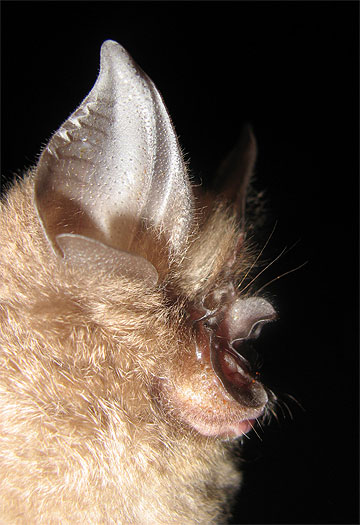Rhinolophus yunanensis
Dobson's Horseshoe Bat; Yunnan Horseshoe Bat
Morphological description Life history Distribution Habitat Roost sites and roosting patterns Emergence and flight pattern Foraging behaviour Echolocation calls Status and protection

Morphological Description
· Dorsal fur is brown. Ventral fur is lighter and slightly pale.
· Juveniles are lighter than adults with a greyish color.
· Average forearm length 56.6mm (54.2-59.5mm) (Bates & Harrison, 1997).
· Although this species is very similar to R. pearsoni, it is larger. The horseshoe leaf covers the whole muzzle. The lancet is longer than R. pearsonii , and triangular and straight sided.
Some authors regard R. yunanensis (found in north east India, north Myanmar, SE China and Thailand) as a species distinct from R. pearsoni (see Csorba et al., 2003). The only reason for this distinction appears to be that R. yunanensis is slightly larger (e.g. forearm lengths 51.5-64 mm vs. 47-56 mm in pearsoni (Csorba et al. 2003)). We still need convincing that R. yunanensis is a species distinct from R. pearsoni: the overlap in forearm lengths between the two putative species is substantial; we have found consistency in echolocation call frequencies of bats that would be described as R. pearsoni and R. yunanensis on the basis of regions of non-overlap in forearm lengths of the putative species (i.e. bats with forearm length < 51.5 mm have a similar call frequency to bats with forearm length > 56 mm) and because we have found no clear divergence in mtDNA haplotypes of bats sampled in China. In other parts of S Asia, differences between R. yunanensis and R. pearsoni may be more apparent: an intermediate species - R. chiewkweeae - has recently been described from peninsular Malaysia (Yoshiyuki & Lim 2005).
Life history
· Little known
Distribution
NE India, N Burma, SE China and Thailand (Corbet & Hill 1992). The Chinese distribution is shown by the dots on the map below (as given by Zhang et al . 1997). The red do is a field record of a bat showing characteristics of this species found by Jinshuo Zhang.

Habitat
· Little known. In Yunnan Province, their main habitat is rainforests.
Roost sites and roosting behaviour
· Generally roosts in caves.
· This species often shares cave roosts with other bat species.
Emergence and flight pattern
· Most rhinolophid bats have wing shapes that make them adept at foraging in cluttered environments.
Foraging behaviour
· Not known.
Echolocation calls
· Apparently R. yunanensis calls at relatively low frequencies in Thailand (51-53 kHz (P. Soisook, pers. comm.) and one bat we caught in China called at 48 kHz and so was substantially different from R. pearsonii. Call frequency may turn out to be a useful character for distinguishing these species.
Status and protection
· There is no estimation of population size for China.
· Dobson's horseshoe bats are at LR/nt, assessed by the Red List of Threatened Species (IUCN, 2007) and are not listed in the Law of the People's Republic of China on the Protection of Wildlife in 1989.
· Caves and rainforests should be protected as their habitats.